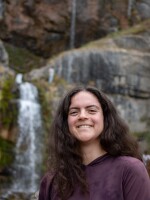For the next year, the second-floor galleries of the Nora Eccles Harrison Museum of Art in Logan are a time capsule.
A slab of masonite in a corner has been painted to show a family in front of a hogan, a traditional Diné, or Navajo, home. The men’s shirts are tucked into their jeans; the women wear long skirts. Another Diné family passes in a string of covered wagons. They’re headed down a dirt road toward orange buttes against a blue sky.
This rescued mural, called “Returning Home,” was painted in the 1960s by a student at Intermountain Indian School in Brigham City. It adorned the school’s cafeteria.
Intermountain operated from 1950 to 1984. In 2013, Utah State University bought the land where it once stood. Before the buildings were demolished, Andy Shinkle, former director of the USU Brigham City campus, cut some of the murals from the walls and stored them in a garage. Most are on sheetrock, and their condition deteriorated.

A committee of alumni, scholars and museum staff advised the murals’ restoration and exhibition, with support from The Terra Foundation for American Art and the National Endowment for the Arts, along with community members. This year, the restored murals are on display alongside artist Sheila Nadimi’s photographs of the Intermountain campus and some of the artwork she found inside.
Intermountain was one of 526 government-funded Indian boarding schools across the United States. They were designed to strip Native children of their cultures. Some were also rife with abuse.
But Ronald Geronimo, an Intermountain alum who started in 1978, doesn’t call himself a survivor.
“Sometimes people don't believe us that we actually enjoyed going to school there, and we actually were encouraged to share our culture and our traditions,” said the enrolled member of the Tohono O’odham Nation in southern Arizona.
Intermountain’s art program, led for its first decade by renowned Apache artist Allan Houser, encouraged students to connect with their cultures. Houser depicted traditional landscapes and figures in murals and inspired students to do the same.
As she looked at “Returning Home,” one of those saved and restored murals, Lorina Antonio saw the artist’s homesickness. She grew up on the Navajo Nation and left for Intermountain when she was 10.
“I was so young I didn’t understand,” she said. “When I first got there, I really cried because I didn’t know where I was.”

Painting was a way for students to express their feelings, she said. Now, after a career as a heavy equipment operator, the Salt Lake City resident is a leader in the Intermountain alumni community. Seeing the exhibit for the first time at the opening reception earlier this year, she wore traditional turquoise jewelry and a long blue skirt dotted with white.
“I’m glad they get to see our work, what we do, and what this school has taught us, and how independent it made us,” she said.
By the 1980s, “the school was a veritable gallery of art,” according to the book “Returning Home: Diné Creative Works from the Intermountain Indian School.” Diné historian Farina King, a co-author, said the students’ artwork speaks to the “very questions of what it means to be human: What does home mean? What is the relationship between people and land and water?”
Antonio was in high school when Intermountain expanded to Native students from across the United States. During the early intertribal years, students came from more than two dozen nations. She remembers the fights that broke out. Existing tensions among tribes were partly to blame, King said, along with teenagers figuring themselves out. Those frictions, and cultural sharing, eventually made their way into the art.
“It got to be an art competition between the Navajo and the intertribal,” Antonio recalled.


As the school became more diverse, so did the artwork.
One of Nadimi’s photographs shows two dancers painted on a white wall. The larger one is adorned with yellow feathers, while the other wears reds and blues and a plant around his neck.
“They're very similar,” Geronimo noted as he looked at the photo. “On [the left] side, that's more of a Pueblo style, with the head mask, and carrying the rattle and plant.”
Dressed in a black jacket with the logo of Tohono O’odham Community College, where he directs the language center, Geronimo said Intermountain was a big part of the person he’s become.
“When I came, there were so many different people in different groups,” he said. “They all had their own language and culture and they shared it with all of us.”

As Geronimo learned about his classmates’ varied backgrounds in school, King said museumgoers can learn from their artwork today. She hopes it will inspire people to expand their knowledge of Native American history.
“They were planting seeds for the future, even while it also was at that time, for them, serving different purposes too — whether it was bringing that peace and harmony into their lives in some very tumultuous times for them.”
She said people who see the paintings today can form their own ideas about it.
“There's so much of knowledge, archive, experience in the art, and we're still learning.”
Repainting the I: The Intermountain Intertribal Indian School Murals and Eagle Village, composed of Sheila Nadimi’s photographs, run through Jan. 17, 2026, at the Nora Eccles Harrison Museum of Art at USU in Logan, Utah.
Macy Lipkin is a Report for America corps member who reports for KUER in northern Utah.


